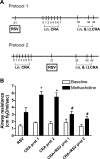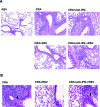Respiratory virus-induced regulation of asthma-like responses in mice depends upon CD8 T cells and interferon-gamma production
- PMID: 17991711
- PMCID: PMC2111117
- DOI: 10.2353/ajpath.2007.070578
Respiratory virus-induced regulation of asthma-like responses in mice depends upon CD8 T cells and interferon-gamma production
Abstract
Respiratory virus infections can significantly influence the development of airway disease by both predisposing and exacerbating the developing lung immune environment. In contrast, the initiation of a more desirable anti-viral response may better prepare the local environment and protect it from developing an adverse long-term disease phenotype. BALB/c or C57BL/6 mice exposed to respiratory syncytial virus (RSV) infection at the same time as allergen sensitization were assessed for airway function, cytokine responses, and inflammatory parameters. Depending on the genetic strain of mouse used, BALB/c versus C57BL/6, RSV could differentially protect against the development of airway allergen responses. Although RSV was able to block allergen sensitization and induction of airway hyperresponsiveness and eosinophilic inflammation in C57BL/6 mice, the infection did not reduce the allergic responses in BALB/c mice. The alteration of airway responsiveness did not depend on the timing of RSV infection in C57BL/6 mice in conjunction to the allergen sensitization protocol. Neutralization experiments demonstrated that interferon-gamma contributed significantly to the RSV-induced airway attenuation of the allergic responses, whereas transfer of CD8 T cells from RSV-infected animals suggested that they were partially responsible for the altered environment. These data suggest that a respiratory viral infection impacts on the local lung environment and may reflect specific aspects of the hygiene hypothesis. However, the outcome of this interaction depends on the immunological response of the host.
Figures





Similar articles
-
Transfer of the enhancing effect of respiratory syncytial virus infection on subsequent allergic airway sensitization by T lymphocytes.J Immunol. 1999 Nov 15;163(10):5729-34. J Immunol. 1999. PMID: 10553105
-
Effects of primary and secondary low-grade respiratory syncytial virus infections in a murine model of asthma.Clin Exp Allergy. 2004 Aug;34(8):1307-13. doi: 10.1111/j.1365-2222.2004.02033.x. Clin Exp Allergy. 2004. PMID: 15298574
-
Respiratory syncytial virus infection results in airway hyperresponsiveness and enhanced airway sensitization to allergen.J Clin Invest. 1997 Jul 1;100(1):226-33. doi: 10.1172/JCI119516. J Clin Invest. 1997. PMID: 9202075 Free PMC article.
-
Respiratory syncytial virus (RSV) evades the human adaptive immune system by skewing the Th1/Th2 cytokine balance toward increased levels of Th2 cytokines and IgE, markers of allergy--a review.Virus Genes. 2006 Oct;33(2):235-52. doi: 10.1007/s11262-006-0064-x. Virus Genes. 2006. PMID: 16972040 Review.
-
CD8+ T cells and immunoregulatory networks in asthma.Springer Semin Immunopathol. 2004 Feb;25(3-4):311-23. doi: 10.1007/s00281-003-0145-z. Epub 2003 Oct 18. Springer Semin Immunopathol. 2004. PMID: 15007634 Review.
Cited by
-
B cell antigen presentation promotes Th2 responses and immunopathology during chronic allergic lung disease.PLoS One. 2008 Sep 3;3(9):e3129. doi: 10.1371/journal.pone.0003129. PLoS One. 2008. PMID: 18769622 Free PMC article.
-
Regulatory T cells and Th1/Th2 in peripheral blood and their roles in asthmatic children.Transl Pediatr. 2013 Jan;2(1):27-33. doi: 10.3978/j.issn.2224-4336.2012.04.03. Transl Pediatr. 2013. PMID: 26835281 Free PMC article.
-
Objectives, design and enrollment results from the Infant Susceptibility to Pulmonary Infections and Asthma Following RSV Exposure Study (INSPIRE).BMC Pulm Med. 2015 Apr 30;15:45. doi: 10.1186/s12890-015-0040-0. BMC Pulm Med. 2015. PMID: 26021723 Free PMC article.
-
STAT3-mediated IL-17 production by postseptic T cells exacerbates viral immunopathology of the lung.Shock. 2012 Nov;38(5):515-23. doi: 10.1097/SHK.0b013e31826f862c. Shock. 2012. PMID: 23042197 Free PMC article.
-
Thymic stromal lymphopoietin is induced by respiratory syncytial virus-infected airway epithelial cells and promotes a type 2 response to infection.J Allergy Clin Immunol. 2012 Nov;130(5):1187-1196.e5. doi: 10.1016/j.jaci.2012.07.031. Epub 2012 Sep 13. J Allergy Clin Immunol. 2012. PMID: 22981788 Free PMC article.
References
-
- Welliver RC. Review of epidemiology and clinical risk factors for severe respiratory syncytial virus (RSV) infection. J Pediatr. 2003;143:S112–S117. - PubMed
-
- Hoffman SJ, Laham FR, Polack FP. Mechanisms of illness during respiratory syncytial virus infection: the lungs, the virus and the immune response. Microbes Infect. 2004;6:767–772. - PubMed
-
- Smyth RL, Openshaw PJ. Bronchiolitis. Lancet. 2006;368:312–322. - PubMed
-
- Effros RM, Nagaraj H. Asthma: new developments concerning immune mechanisms, diagnosis and treatment. Curr Opin Pulm Med. 2007;13:37–43. - PubMed
Publication types
MeSH terms
Substances
Grants and funding
LinkOut - more resources
Full Text Sources
Medical
Molecular Biology Databases
Research Materials

